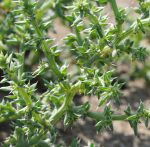 Also known as common saltwort, prickly Russian thistle. windwitch, and tumbleweed, this native of Eurasia grows widely in arid and semiaride regions and is considered an invasive weed in many areas. An bushy annual, fuller’s soap is a member of the goosefoot family, Amaranthaceae, that also includes celosia, beets, and spinach. Plants have a taproot up to three feet long with extensive lateral roots. Its highly branched stems grow eight to thirty six inches long and usually have reddish to purplish stripes. The stems are soft and green at first but become somewhat woody with age. The first leaves are one inch long, dark green, cylindrical and fleshy at but later leaves are stiff and short with a sharp tip. The flowers lack petals and are produced in the upper leaf axils, subtended by a pair of small spine tipped bracts. They appear from mid summer into fall and are followed by black, shiny,winged seeds that remain in the leaf axils until the plant dies, dries, breaks off at soil level, and becomes a tumbleweed, dispersing the seeds as the plant is blown about by the wind. Photo Credit Wikimedia
Also known as common saltwort, prickly Russian thistle. windwitch, and tumbleweed, this native of Eurasia grows widely in arid and semiaride regions and is considered an invasive weed in many areas. An bushy annual, fuller’s soap is a member of the goosefoot family, Amaranthaceae, that also includes celosia, beets, and spinach. Plants have a taproot up to three feet long with extensive lateral roots. Its highly branched stems grow eight to thirty six inches long and usually have reddish to purplish stripes. The stems are soft and green at first but become somewhat woody with age. The first leaves are one inch long, dark green, cylindrical and fleshy at but later leaves are stiff and short with a sharp tip. The flowers lack petals and are produced in the upper leaf axils, subtended by a pair of small spine tipped bracts. They appear from mid summer into fall and are followed by black, shiny,winged seeds that remain in the leaf axils until the plant dies, dries, breaks off at soil level, and becomes a tumbleweed, dispersing the seeds as the plant is blown about by the wind. Photo Credit Wikimedia
Soap was made in ancient Palestine by burning plants of saltwort and mixing the ashes with olive oil. Three species of saltwort were available in the area but this one was the most common. The identification of this species as that intended in the Bible is by no means certain. Several washing products are mentioned in the Bible but none of these are translated as fuller’s soap or connected with saltwort.
Malachi 3.2 KJV God promises the Israelites to send a messenger of the covenant.
“But who may abide the day of his coming? and who shall stand when he appeareth? for he is like a refiner’s fire, and like fullers’ soap:”